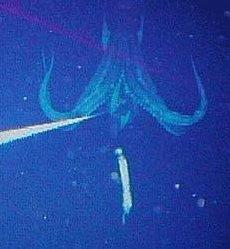 [[S C I E N C E]] * In his extraordinary 1870 novel 20,000 Leagues Under the Sea, French stockbroker turned novelist Jules Verne imagined a confrontation between the crew of Captain Nemo’s submarine, the electric-powered and twin-hulled Nautilus, and more than half a dozen giant squid living near the Bahamas. With the Nautilus having surfaced, one of the mighty, eight-tentacled mollusks grabs a sailor from a hatch using one of its 16-foot-long tentacles. Protagonist Ned Land describes the scene:
[[S C I E N C E]] * In his extraordinary 1870 novel 20,000 Leagues Under the Sea, French stockbroker turned novelist Jules Verne imagined a confrontation between the crew of Captain Nemo’s submarine, the electric-powered and twin-hulled Nautilus, and more than half a dozen giant squid living near the Bahamas. With the Nautilus having surfaced, one of the mighty, eight-tentacled mollusks grabs a sailor from a hatch using one of its 16-foot-long tentacles. Protagonist Ned Land describes the scene:The poor man, in the grip of that tentacle, held fast by its suckers, was dangling in the air, at the mercy of that enormous arm. He was gasping, choking, and kept shouting: “Help! Help!” ... I shall remember his heartrending cry to the end of my days!Of course, that was science fiction. But yesterday, the giant squid of maritime legend gained further factual substance, when Japanese scientists announced that they’d photographed a 26-foot-long specimen hunting prey nearly 3,000 feet beneath the Pacific Ocean’s surface, off the coast of Japan’s volcanic Bonin Islands. In fact, they released more than 500 shots of this “purplish red” creature, taken in October 2004 by a remote-control camera. “We believe this is the first time a grown giant squid has been captured on camera in its natural habitat,” says marine researcher Kyoichi Mori.
The poor fellow was lost. Who could save him from that powerful grip? Nevertheless, Captain Nemo had rushed at the squid, and with one blow of his ax had hacked off another of its tentacles. The second-in-command was battling furiously with other monsters, which were climbing up the sides of the Nautilus. The whole crew was battling furiously. ...
For a moment, I thought that the unfortunate man entangled in the clutches of the squid would be freed from those powerful suckers. Seven of the eight tentacles had been cut off. The remaining one brandished its victim, dangling in the air, like a feather. But just as Captain Nemo and his lieutenant plunged at it, the animal threw up a jet of black liquid, which these animals secrete in a sack of the abdomen. We were blinded by it. When the black cloud had cleared away, the squid had disappeared, and with it my unfortunate fellow countryman!
The giant squid, genus Architeuthis, is the source of 16th-century Norwegian lore about the kraken, sea monsters “the size of a floating island” that attacked sailing vessels and could suck unfortunate sailors down into the briny depths with the whirlpools they created simply by diving rapidly. It wasn’t until the 19th century, though, that credible evidence was found of such carnivorous beasts. In 1873, a giant squid assaulted a minister and a boy on the coast of Newfoundland, Canada, and five years later, a 20-foot-long, 2.2-ton specimen of the mysterious breed washed ashore, also in Newfoundland. A still larger squid was found alive in 1878 in New Brunswick, Canada’s Timble Tickle Bay. As the Museum of Unnatural History Web site explains, “Three fisherman were working not far off shore when they noticed a mass floating on the ocean they took to be wreckage. They investigated and found a giant squid had run aground. Using their anchor as a grappling hook they snagged the still living body and made it fast to a tree. When the tide went out the creature was left high and dry. When the animal died, the fishermen measured it and then chopped it up for dog meat. The body of the squid was twenty feet from tail to beak. The longer tentacles measured thirty five feet and were tipped with four inch suckers.”
 In 1966, two lighthouse keepers at the appropriately named Danger Point, South Africa, watched as a baby southern right whale was assaulted by a giant squid, which finally drowned it while its mother looked on helplessly. A live specimen was stranded in Japanese waters in 2002, and a year later, another oversized invertebrate latched onto a sailboat off the coast of Brittany, France. Unbelievably enough, that boat happened to be entered in the famous Jules Verne Trophy around-the-world sailing competition. According to the BBC News, only about 250 giant squid sightings--“mostly of dead animals--have ever been recorded.” A 30-foot-long specimen was placed on display at London, England’s Natural History Museum earlier this year.
In 1966, two lighthouse keepers at the appropriately named Danger Point, South Africa, watched as a baby southern right whale was assaulted by a giant squid, which finally drowned it while its mother looked on helplessly. A live specimen was stranded in Japanese waters in 2002, and a year later, another oversized invertebrate latched onto a sailboat off the coast of Brittany, France. Unbelievably enough, that boat happened to be entered in the famous Jules Verne Trophy around-the-world sailing competition. According to the BBC News, only about 250 giant squid sightings--“mostly of dead animals--have ever been recorded.” A 30-foot-long specimen was placed on display at London, England’s Natural History Museum earlier this year.After hearing about that 2004 Japanese film of a giant squid, Jim Barry, a marine biologist at California’s Monterey Bay Aquarium Research Institute, enthused, “It’s the holy grail of deep sea animals. It’s one that we have never seen alive, and now someone has video of one.”
READ MORE: “Giant Squid: Don’t Mess With Them,” by Grady Hendrix (Slate); “Legendary Monster Is Captured on Film,” by William J. Broad (The New York Times); “One Legend Found, Many Still to Go,” by William J. Broad (The New York Times); “My Deep Sea Dreams,” by Steve O’Shea (The New York Times).







1 comment:
here is aclip of Karina Stenquist fighting against the Squid. There is also a bit of the story
http://www.mobuzz.com/shows/2180.html
Post a Comment